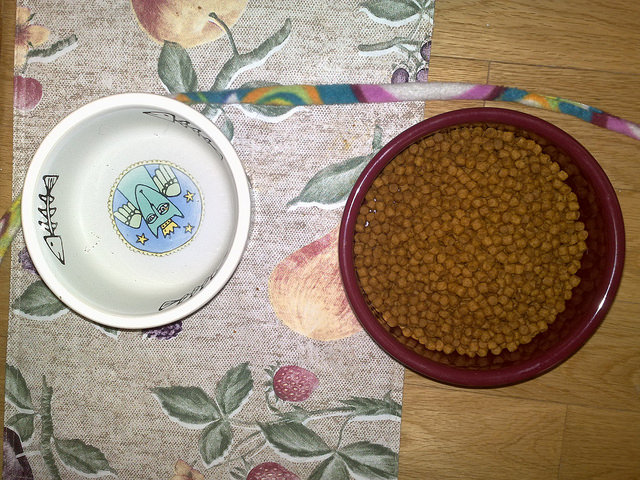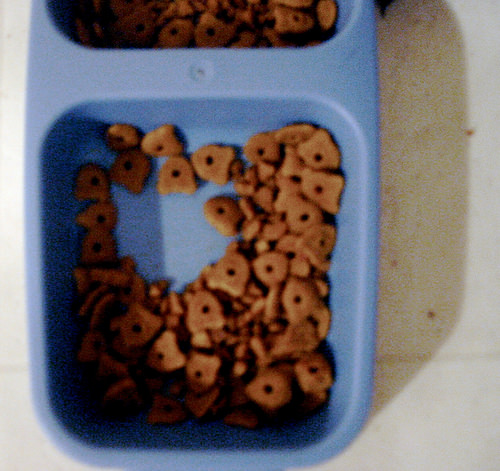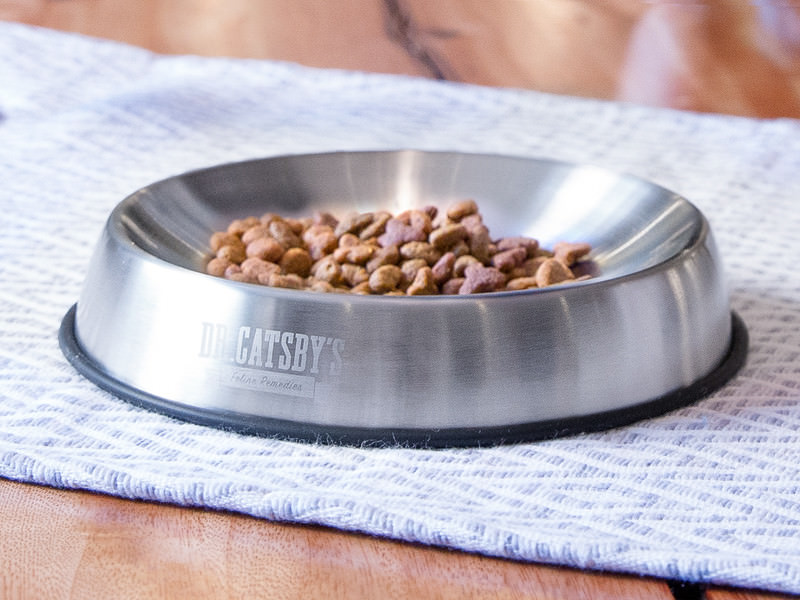We all know cats can be picky when it comes to eating. Many of us have experienced the frustration of a cat that, day after day, turns their nose up at whatever we put in their dish. At this point, you are starting to think your cat doesn’t like you. New insight says that it might not actually be the contents of the dish that is bothering your cat, but the dish itself.
Kitty Ergonomics
Humans know full well that there is no such things as “one size fits all.” Even for things like eating and drinking utensils. A 6’ 4” adult man is not going to be comfortable trying to eat with a baby spoon. Likewise, a toddler may find our giant coffee cups heavy and therefore be unable to drink properly from them.

Loren Kulesus, inventor of Dr. Catsby’s Food Bowl For Whisker Fatigue, explains in an interview with iHeartCats.com that cats have ergonomic factors that many owners never think about:
Cats have ergonomic needs too. Like a fork or spoon, a food bowl can be fitted for a cat’s needs and comfort.
Most cats have a blind spot directly beneath their nose. This means that they sometimes cannot even see the food directly touching their mouth. They can smell the food and feel it, so when their food gets caught in a tight corner of their food bowl, they might press their nose with force into the corner and nudge the food around.
If we consider a food bowl to be a utensil for cats like a fork or a spoon for humans, we can see that this object has not been optimized or has not fully considered the cat’s comfort or needs.

Why don’t all cats act picky then?
“Cats’ personalities span a wide range of pickiness so some cats may express their frustration with a bowl that prevents them from fully enjoying their food, while others might not show any obvious or outward signs they approve or disapprove,” Kulesus said.
So, it could be your cat has just gotten used to a bowl that may not be that comfortable, or maybe your kitty is just not as vocal about his problems, you know the “suffer in silence” type.
Look For The Signs
So what are the signs that your cat’s dish might be the source of your mealtime woes?
Kulesus says to look for the following signs:
- You changed food and your cat seems to show no interest or is crying at you
- They quickly eat out the middle, but then stop eating when the food is bunched up in the corners and cry at you for more food.
- Knocking over the food bowl
- Knocking the food out
- Nudging the bowl around
- Some cats will even scoop the food out of the dish with their paw, and eat it off the ground instead.
Cat Dish Variables
When picking out a cat dish, here are a few things to think about, according to Kulesus:
- It is important to use a bowl that is non-porous, which means that plastic bowls are not a good fit for cats (including the so-called “food safe” plastics) because their nose and face comes into contact with the bowl and plastic is subject to micro-abrasions that allow bacteria to grow.
- This bacteria can withstand even the heat and conditions of a dishwasher, and repeated contact with these surfaces has led to cases of feline acne where abscesses appear around the cat’s nose and mouth. In order of appropriateness, stainless steel is best, glass, and then ceramic. Plastic should be avoided.
- Height of bowl is an interesting thing because some research has indicated that some elderly cats digest better when the bowl is in a slightly elevated position. If you have noticed your cat having trouble digesting or if they have joint pain, elevating the bowl may possibly provide them some relief.
- Many people have observed that their cat seems to prefer having their water bowl in a separate location from their food bowl because it encourages their natural hunter instincts, also some cats won’t drink water when it is close to their food. Multiple water sources are a good thing for them too.
The NEW Bowl In Town
All this research came about because Kulesus noticed his own cat was having trouble eating – making a mess with his food, crying and pacing around his bowl. He had a theory that the bowl, not the food, was the culprit. He would only eat the food in the middle of the bowl, leave the rest and cry like he was still hungry.
“I found that rearranging the food would allow him to eat out of the middle again, but this cycle would repeat. What was he trying to tell me?” Kulelus wondered. “Then, I noticed he would smack food out of the bowl with his paw to eat it off the floor. So, I started watching him very carefully while he ate and I realized he might be uncomfortable somehow.”
He decided to find out.
“I started researching online and started to learn about how cats’ whiskers are super important and sensitive, and they can experience whisker fatigue. When he was digging in the corners of the food bowl, he would get frustrated quickly and give up. He was experiencing whisker pain!”
Being an industrial designer, he went to his business partner and asked if he would help.

“I had done lots of ergonomic studies in college and applied the same ergonomic data as a designer of furniture, automobiles, and electronics,” he explains. “I realized that I could do the same for a cat. I measured out his face and whiskers and then created a digital simulation to create a shape for a bowl that would be perfect for him, allowing minimal contact with his whiskers and absolutely no corners. I 3D modeled it and then I 3D printed one out of a bio-plastic called PLA (good for a test, but not a long term material solution) and then I fed him with it.
I was so happy when he for the first time finished his food without any complaints, mess, or crying. It is what he had been telling me all along, and I felt so happy that I could make this necessary task of feeding enjoyable to him again.”
Then they designed a few prototypes and invited cat owners to participate in their experiment. Their results were telling:
We developed a test ergonomic bowl (our concept) and a control bowl (same size but with 80 degree corners and a flat bottom) and instructed the participants on how to test each of the bowls to see if their cats had a preference. In the first 3 days, most people did not recognize the cat liking one bowl over the other, but after a full week the subjects ranged from preferring the ergonomic bowl to eating only out of that one! To our delight, many of the subjects wanted to keep the test bowl after the experiment because they realized how much their cats liked eating from it. Cats care about the type of bowl they eat out of.
Basically, this new bowl keeps the food in the middle of the dish, and has no corners, so your cat can eat his entire meal without having his sensitive whiskers touch the bowl.
What about water bowls?
Kulelus explains that water bowls don’t usually create a problem since the water “self-levels.” As long as it’s wide enough for them to drink out of, they can drink from the middle and avoid whisker fatigue.
